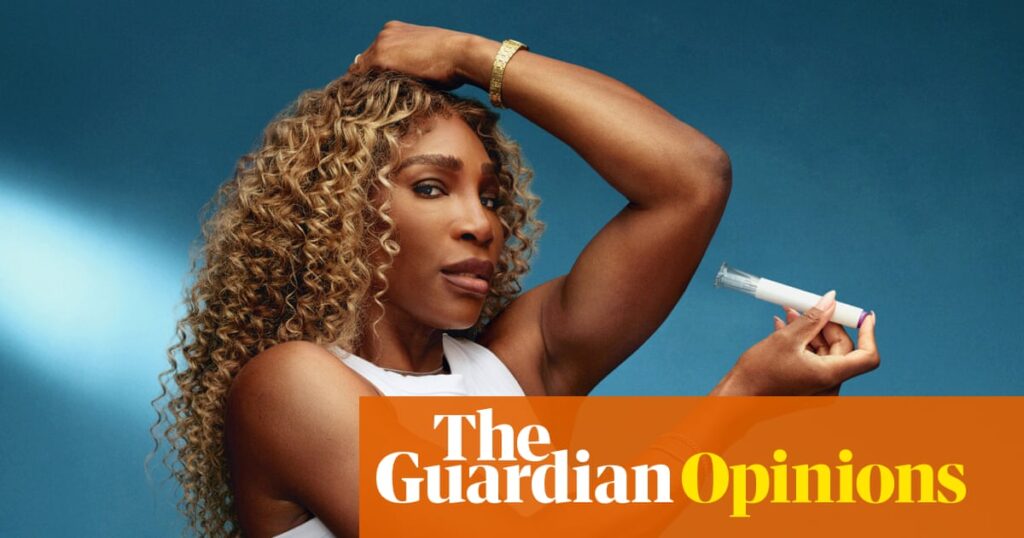
When Serena Williams was featured in a People magazine story on Thursday morning discussing her 31lb weight loss, the rollout had all the hallmarks of an advertisement draped in the thin veil of an all-caps EXCLUSIVE.
Vogue’s social channels amplified their own access, NBC’s Today show gave her a one-on-one segment and Elle published a carefully packaged interview in which Williams declared she wanted to break the stigma around weight-loss drugs, each of them in lockstep with what appeared to be a hard 9am press embargo. This vintage Jill Smoller quadrafecta was not a spontaneous confessional; it was a coordinated media blitz pegged to the US Open, the tentpole event of American tennis, which kicks off on Sunday in earnest.
Yet for all the precision and polish, it was unmistakably a commercial. The product wasn’t just Williams’s refined physique, already the subject of months-long speculation among her 32 million followers across social media. It was a telehealth service called Ro – a company on whose board her husband, Alexis Ohanian, conveniently sits, a disclosure the press release at least did the courtesy of including in a footnote – promoting access to GLP-1 weight-loss drugs such as Ozempic, Wegovy and Zepbound.

By aligning with Ro, Williams has gone from embodying resistance to helping mainstream an industry built on shrinking bodies. The woman who once crafted a superpower from her double burdens – of being born a woman and being born Black in America – has chosen to reinforce the very culture that sought to erase her. Critics argue it’s especially dissonant given her own history of nearly dying twice – once from a pulmonary embolism after stepping on broken glass, once from a traumatic C-section recovery – experiences that exposed the structural failures of American healthcare, particularly for Black women. If anyone could have credibly used her platform to call for systemic reform, it was her. Instead, she’s lent her name to a for-profit enterprise that markets weight-loss drugs to those who can already afford concierge medicine.
And make no mistake: this is part of a bigger push. Between 8% and 10% of Americans are now taking GLP-1s, according to PricewaterhouseCoopers. Ro has already run a controversial subway campaign showing injected bellies and signed former NBA star Charles Barkley to inject himself on camera. Competitor Hims & Hers splashed out for a Super Bowl commercial. All have drawn fire: from politicians who complained about skipped side-effect disclosures, from activists who saw body-shaming propaganda and from doctors worried about malnourishment. Unlike traditional pharma, telehealth companies in the US don’t have to run long read-outs of risks. They can present drugs like lifestyle accessories. And now they have a real American hero as their most bankable face in the gold rush for market share.
Williams is not alone in this. She joins a growing roster of celebrities who have gone public about GLP-1 use, among them Oprah Winfrey, Whoopi Goldberg, Meghan Trainor and Amy Schumer. But if others generated curiosity, Serena brings legitimacy. Few endorsements could signal more clearly that weight-loss drugs have moved from Hollywood whispers into the glossy mainstream.
The money question lingers uncomfortably. Williams is not a retired athlete scrambling for relevance. She is married to an uber-wealthy tech founder and has amassed generational wealth of her own, yet her endorsements in recent years have increasingly tracked with the aesthetics of Silicon Valley affluence and a curated tradwife domesticity, a jarring turn for someone once defined by rebellion.
As a Black woman in the public eye, Williams has always faced a disproportionate level of scrutiny over her body – her musculature, her curves, her clothing choices – scrutiny that her white peers rarely endured in both volume and scale. Chris Evert wrote her a patronizing open letter doubting her commitment. Pat Cash declared her washed up (in 2007!).
That grim history helps explain why many of her fans in friendly spaces like the Shade Room comments responded with empathy, acknowledging both the hormonal struggles she described and the impossible double bind she has lived under: at once a legend who redefined beauty and power, and a woman relentlessly policed for the body that made her great. But still others lamented the disappearance of the muscular body she once defended, and suspected that she was reshaping herself, and her brand, to fit into that conventional mold.
GLP-1 drugs can be life-changing for people with obesity or diabetes. But they also underscore grotesque inequality. Wealthy Americans spend thousands a month to stop snacking. But pharmacies ration supply and insurers refuse coverage. For critics, the glamorization of the practice by Williams, once the living rebuttal to those hierarchies, only deepens the inequity. Williams’s greatness on the court is beyond any credible dispute. But her embrace of GLP-1 culture is a reminder that even the most untouchable of legends can be co-opted, and that in a society obsessed with shrinking, even our icons are made to disappear.




